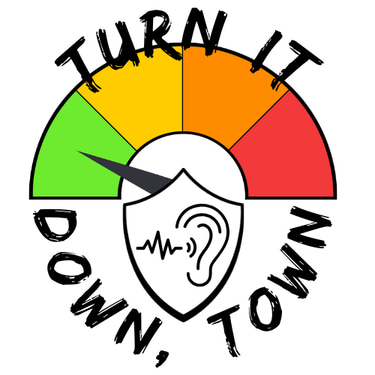No-Cost Sound Solutions
Turn down the music.
Many places default to louder background music, thinking it adds energy. But lowering the volume by even 10–20% can reduce vocal strain, improve conversation clarity, and make the space feel more relaxed. It’s a simple adjustment that signals care for all guests, especially those with sensory sensitivities.
Close doors to separate loud and quiet zones.
Keeping doors closed between louder and quieter areas helps contain sound and prevent it from spilling into spaces meant for conversation or relaxation. It’s a simple habit that creates instant acoustic boundaries — no construction required.
Use curtains or blinds over windows.
Even basic window coverings like curtains or blinds can help soften sound by reducing hard surface reflections. They also block outside noise from entering and keep indoor sound from bouncing around, making the space feel calmer and more contained.
Rearrange furniture to create sound barriers.
Strategic furniture placement — like positioning bookshelves, booths, or tall plants — can help block and redirect sound. These natural barriers break up open spaces and reduce how far noise travels, creating quieter pockets within your layout.
Keep floors clean and clutter-free.
A tidy floor reduces sound reflections and trip hazards. Clutter like boxes or hard bins can amplify noise when bumped or moved. Keeping walkways clear helps maintain a calm, unobstructed sound flow — and makes your space feel more welcoming.
Encourage staff to speak at a moderate volume.
Gentle reminders or modeling quieter speech can set the tone for the whole environment. When staff speak calmly, customers often follow suit, naturally lowering the overall noise level without needing signs or enforcement.
Use soft skills to de-escalate loud moments.
Training staff to respond with empathy and calm tones during noisy or stressful interactions can prevent sound from escalating. A kind word or a gentle redirect can do wonders for keeping the atmosphere peaceful and inclusive.
Place plants strategically.
Live or artificial plants — especially tall or leafy ones — can help break up sound paths and soften acoustics. If you already have greenery, placing it near walls or open areas adds a natural buffer without spending a dime.
Stagger seating to avoid clusters.
Spacing out seating — even slightly — helps prevent sound from building up in one area. It encourages more even distribution of voices and reduces the chance of overlapping conversations becoming overwhelming.
Use corners wisely.
Corners can trap and amplify sound. Placing soft items like a chair, plant, or even a coat rack in a corner helps diffuse sound energy. If your space already has these features, you’re passively improving acoustics without lifting a finger.
Quiet doesn’t have to cost a thing.
This section features simple, no-cost strategies that individuals and businesses can use to reduce sound overload and create more inclusive environments. From rearranging seating to adjusting volume settings, these ideas are designed to be easy, effective, and accessible to everyone—no budget required.
Whether you're a restaurant owner, church volunteer, or someone trying to make your space more welcoming, these solutions offer a practical starting point for sound-conscious change.
Other Sound Solutions
AIL Sound Walls
Focus: Municipal and institutional noise mitigation
Applications: Schools, hospitals, wastewater plants, rooftop enclosures, and more
Highlights: Lightweight, environmentally friendly systems that install quickly with local crews
Website: www.ailsoundwalls.com
Sound Fighter Systems
Focus: Industrial, commercial, and public site noise control
Services: Connects clients with expert contractors for sound wall installation
Highlights: Nationwide network, precision installation, and regulatory compliance support
Website: www.soundfighter.com
Oldcastle Infrastructure
Focus: Precast concrete sound walls for roads, businesses, and residential areas
Products: SierraWall series with various textures and designs
Highlights: Durable, aesthetic, and customizable wall systems
Acoustiblok Inc.
Focus: Outdoor and indoor noise reduction for public, industrial, and commercial spaces
Products: AcoustiFence, All Weather Sound Panels, QuietFiber, and custom barrier systems
Highlights: Patented materials, flexible installation, effective for parks, venues, and urban areas
Website: https://acoustiblok.com/
Easi-Set Worldwide
Focus: Precast concrete sound walls for highways, railways, and public infrastructure
Products: SoftSound absorptive walls, Sierra Wall reflective barriers
Highlights: Modular design, rapid installation, durable and customizable textures
Website: https://easiset.com/
Kinetics Noise Control
Focus: Engineered acoustic solutions for architectural and environmental noise control
Products: Outdoor barrier walls, acoustic panels, vibration isolation systems
Highlights: Custom designs, acoustic consulting, used in schools, public buildings, and outdoor spaces
Website: https://kineticsnoise.com/
Investing in quieter spaces.
This page highlights products and strategies that may involve a financial investment—from acoustic treatments and signage to sound-level meters and design upgrades. These solutions can make a meaningful impact in reducing noise and improving accessibility, especially in high-traffic or complex environments.
We don’t sell these items ourselves, but we’ve curated them to help you explore what’s possible. Whether you're working with a small budget or planning a larger transformation, these ideas are grounded in real-world experience and chosen with inclusivity in mind.
Share Your Sound Solution!
Have you found a creative way to reduce noise or make a space more sound-conscious? Whether it’s a no-cost adjustment or a product that made a difference, we’d love to hear about it.
Turn It Down, Town is built on lived experience and community wisdom. Your ideas—big or small—can help others feel more welcome, safe, and included.
Use this form to tell us about your solution. While photos can’t be uploaded, we encourage you to provide as much detail as possible—what worked, where it helped, and why it matters.
Turn it Down, Town
Promoting sound-conscious public spaces for all.
Subscribe!
No noise, just news once a quarter! Get on the list!
© 2025. All rights reserved.
Site Designed by: Budde Designs
